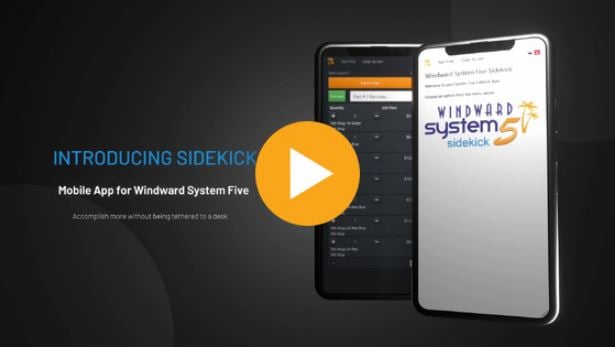Overview
This process will walk you through the setup of Microsoft Authenticator through a Browser Extension. This option is an excellent alternative to using a mobile device when that isn't an option for an employee.
This allows Two Factor Authentication codes to be received using a web browser eliminating the use of the Microsoft Authenticator App on a mobile phone.
If you have users float and use different workstations. Use the steps in the Backup and Import sections to load the Browser Extension and authenticator codes onto workstations that require this.
How to use Microsoft Authenticator Browser Extension
- Go to https://authenticator.cc/
- Choose your Browser from the dropdown. The Default is set to Add to Chrome. In this document, we will be adding the Authenticator Extension to Chrome. If you want to use Edge or Firefox, the process will be similar. However Edge doesn't allow the Authenticator extension to be pinned to the toolbar, so I do recommend using Chrome.
- Click the Add to Chrome button.

- This will take you to the download page for the Chrome Extension.
- Click the Add to Chrome Button.
- Click the Add extension button.

- This will take you back to the Authenticator Extension Page.
Add Your First Account
To add your systemfiveoncloud.com account to Authenticator Extension.
- Install Authenticator Extension as explained in the previous steps (Chrome, Firefox, Edge)
- When you first install Authenticator Extension, you should pin its icon to the toolbar.
To do this, click on the extension icon on your toolbar, then click on the thumbtack icon next to authenticator.

Add an Account Using a QR Code
- Open the MFA Portal in Chrome.
For North American users, go to: http://na.windwardoncloud.com
For Australian users, go to: http://au.windwardoncloud.com - Log in with your Windward On Cloud username and password.
- Choose Microsoft Authenticator when prompted to add Microsoft Authenticator to your account.
- Ignore steps 1 and 2 in the popup. Click Authenticator Extension’s icon (highlighted in yellow) in the top right corner of your browser.

- Click the scan icon (highlighted in yellow) at the top right corner of the Authenticator window.

6. Click and drag your mouse pointer to draw a square that completely surrounds the QR code. You will need to leave a bit of white space around the QR code. If you draw the square too close to the QR code or touching the QR code it will highlight it rather than scan it. If that happens, then repeat steps 5 and 6 again.
- If the QR code was read correctly, then you will get the following window. Click OK.

Add Another Account Using a QR Code
- Open the MFA Portal in Chrome.
For North American users, go to: http://na.windwardoncloud.com
For Australian users, go to: http://au.windwardoncloud.com - Log in with your Windward On Cloud username and password.
- Choose Microsoft Authenticator when prompted to add Microsoft Authenticator to your account.
- Ignore steps 1 and 2 in the popup. Click Authenticator Extension’s icon (highlighted in yellow) in the top right corner of your browser.

- Click the scan icon (highlighted in yellow) at the top right corner of the Authenticator window.

6. Click and drag your mouse pointer to draw a square that completely surrounds the QR code. You will need to leave a bit of white space around the QR code. If you draw the square too close to the QR code or touching the QR code it will highlight it rather than scan it. If that happens, then repeat steps 5 and 6 again.
- If the QR code was read correctly, then you will get the following window. Click OK.

Repeat this process for all users that will be signing into System Five on Cloud.
Backup The User's Authenticator Profiles
Once all the users have been configured in the Authenticator Browser Extension. Use these steps to back up those profiles which can also be restored in the Authenticator Browser Extension on other workstations.
To do this, open Google Chrome:
1 - Click on the Authenticator Browser Extension Icon on the menu bar in Chrome.
2 - Then click on the settings icon in authenticator.

3 - Click on Backup

4 - Click Download Backup File

5 - This will download your Authenticator credentials to a text file and put it in your windows download folder.

Copy the file from the downloads folder to a USB stick so you can transport it to the next computer that you want to import the Authenticator credentials to.

Import The User's Authenticator Profiles Into Authenticator on another Workststion
Take the USB stick that you copied the Authenticator.txt file to, and insert it into the computer that you need the credentials copied to.
Open Google Chrome
1 - Click on the Authenticator Browser Extension Icon on the menu bar in Chrome.
2 - Then click on the settings icon in authenticator.

3 - Click on Backup

Click on Import Backup

Click o Import Backup File.

Browse to the USB stick that contains the Authenticator.txt file, click on it and click the Open button.

You will get a popup stating Authenticator Success. Click OK
Now when you open the Authenticator Browser extension you will see each use with their own Authentication code.
In my example I exported and imported my codes into the same Authenticator so the codes are duplicated. In a real case scenario each user will be showing as their cloud login user name so they can identify which MFA code they need to use.

Now that the Authenticator Web plugin has been configured, click the On the Authenticator icon in the Google Task Bar.
This will open the Authenticator pop up window that contains the MFA Code to enter in the text box on the MFA window.
Enter that code in the "by the Microsoft Authenticator app" text box and click the Verify Code button.
A handy shortcut here is that rather than having to remember the code and typing it into the MFA code text box, you can click on the Authenticator code and you will see a popup asking if you want to allow the web extension access to your clip board. This should only need to be done once. If you allow that it will simplify your MFA process by allowing you to click on the MFA code to copy it to your clipboard and then you can simply right click on the "by the Microsoft Authenticator app" text box and paste it into the text field.
*** Please not that this copy and paste process hasn't worked in all workstation environments due to different security features enabled on the workstation. In those cases, you will need to remember the 6 digit code and manually type it into the MFA screen.

** Note: If the code in the ADSelfService Plus window changes to red or starts flashing red, then that code is about to expire. In that case, wait for the new code and enter that new code into the text box on the MFA window.
There is a little Pie Chart icon in the bottom right of the code window showing a representation of how much time is left for the current password.

8. You should receive a popup saying that the enrollment was successful and you will see a new entry in the window.
Now when you log into the cloud environment and are prompted for your MFA Code, simply open Google Chrome and click the Microsoft Authenticator Icon in the top menu bar. Use the code supplied there in your MFA log in window.

When you are logging into the cloud environment, there is a check box that says "trust this computer". If you check that box, it will reduce the number of times you need to enter the MFA Codes, and will not prompt again in 14 days. This is especially helpful when you are logging in and out of a workstation multiple times per day.
Created By Steve Wind June 26 2024





